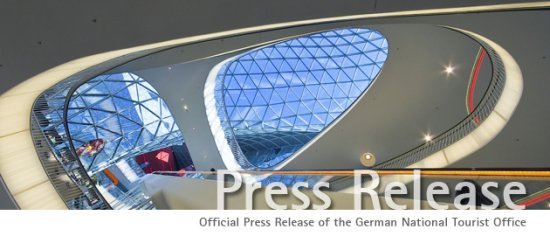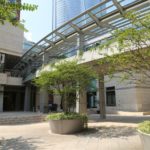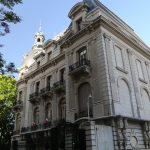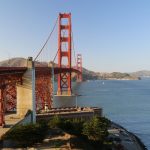
Nothing is just “normal” in Germany – museums, concert halls and even shopping centers are breathtaking architectural masterpieces in the cities belonging to Germany’s Magic Cities association, including Berlin, Cologne, Dresden, Duesseldorf, Frankfurt, Hamburg, Hannover, Leipzig, Munich and Stuttgart. Combining form and function, cutting-edge design and attention to detail, great innovations in architecture and design from the Brandhorst Museum in Munich to the Elbphilharmonic in Hamburg manifest Germany’s main cities’ reputation as fascinating destinations. www.magic-cities.com
Cool Architecture, Hot Shopping
World-class shopping is one of the main features of Germany’s Magic Cities. Trendy design stores or large shopping centers find their home in some of the most fascinating architectural masterpieces. The MyZeil shopping mall in Frankfurt opened in 2009 and is one of the most modern shopping centers in Europe, housing 100 shops, a movie theater, fitness center and much more on 105,000 square feet. Designed by star-architect Massimiliano Fuksas, the MyZeil’s main feature is its fluidity, combining the different levels of the glass constructions beyond the traditional floor design.
Ambitious is probably the best word to describe the large glass construction of the Weltstadthaus in Cologne’s center, home of the department store Peek&Cloppenburg. Designed by Italy’s star architect Renzo Piano, the building is a savant blend of glass, steel, stone and wood: classic materials to dress a modern building, entirely dedicated to fashion. Finished in 2005, the 23,000 square feet building forms a giant slug with glass-facades, making it a true masterpiece of modern architecture.
Modern Urban Architecture
Directly in the heart of the Hamburg, probably the biggest and most exciting European city development project is taking shape: The “HafenCity” (Port City) is a new district of 0.6 square miles, partially built into the water. It encompasses residential, office and event venues, museums as well as large free spaces – all on the edge of the River Elbe and within the second largest port in Europe. Started in 2000, the development is already finished half way with 1,500 people living in the brand new apartment buildings and 6,000 people working there. Flagship of the HafenCity will be the new Elbphilharmonic, designed by Swiss star architects Herzog & de Meuron. The concept is based on the existing brick-wall building, which will be topped off with a light glass-structure consisting of over 1000 individual elements and will be over 360 feet high. The Elbphilharmonie will open in 2012 and will be Hamburg’s new cultural beacon, with its two concert auditoriums and a five-star hotel.
If you want to see what’s happening in today’s architecture, Duesseldorf’s MediaHarbor is the place to go. Against a historical backdrop, you’ll find contemporary works of the German and international star architects from David Chipperfield, Frank Gehry, Bob Gansfort to Renzo Piano. The area has become a destination for architectural tourism, with groups of fascinated visitors gravitating to the highlights – especially to Frank Gehry’s Leaning Towers. As a hub for new media and advertising companies, hip nightlife and great restaurant the MediaHarbor is a fascinating development, combining the individual vision of the architects with the historic buildings of the old harbor.
Another definite eye catcher is the Nord/LB Bank building in Hannover’s city center. The bank’s flagship building was designed by the acclaimed architects Behnisch+Behnisch from Stuttgart. Finished in 2002, it occupies an entire city block and serves as an important link between the various activities which define the neighboring quarters of the city: retail, commercial, residential, cultural, sport and leisure. Through varying heights a building emerges which gently integrates itself in the existing fabric of the city. The facade is constructed totally of glass and the distinguishing feature is an asymmetrical 230 foot high tower, built over a large public courtyard. This courtyard is characterized, but not dominated by the daily operations of the bank itself and further enlivened by shops, restaurants, cafes, large reflecting pools, extensive landscaping and public art.
Great Museums, Fascinating Art, Modern Architecture
Since 2009 the Museum Brandhorst is the newest addition to Munich’s Pinakothek campus, which also is home to the Alte and Neue Pinakothek and the Pinakothek der Moderne museum. The Brandhorst collection of modern and contemporary art is world-renown including works from Picasso, Andy Warhol, CY Twombly and Gerhard Richter. Designed by Sauerbruch Hutton Architects in Berlin the museum is a combining cutting-edge design, ecological approaches and modern museum technology. It is a long, two-story, rectangular structure abutting a considerably higher, trapezium-shaped section housing large and light gallery spaces. The facade looks like an abstract painting and draws attention to the building’s function as an art museum. It comprises various layers with different functions.
Reopened in 2009 after half a century the New Museum in Berlin is the final piece of the Museums Island in Berlin, a UNESCO World Heritage Site. Built in the 19th century, the museum was badly damaged in World War II and its reconstruction started in 2003 after the plans of star architect David Chipperfield. Keeping the integrity of the historic building, the interior is a breathtaking combination of modern and historic elements housing the Egyptian Museum, the Museum of Prehistory and Early History and various artifacts from the Collection of Classical Antiquities. Chipperfield takes the visitor on a fascinating journey and the new design is a dialogue between the historic parts and the newly designed element combining to a unique architectural and museums experience.
Stuttgart is inseparable from the car brands of Mercedes and Porsche that combine technical innovation, cutting edge-design and long-lasting tradition. All these features can be found in the Mercedes-Benz-Museum and the Porsche Museum, showcasing the companies’ histories in fascinating architectural settings of international acclaim. The Porsche museum opened in 2009 and its virtually floating exhibition hall, designed by the Vienna based architect Delugan Meissl, is a futuristic eye catcher next to the company’s main headquarters and factory in Stuttgart-Zuffenhausen.
The Mercedes-Benz-Museum right next to the headquarter in Stuttgart is another example of the connection of cars and slick architectural design. Developed by UNStudio the building is structured around three loops forming a stylized clover leaf. The outside is an intertwined facade of aluminum and glass giving the building a clean and modern look. On the nine connected levels inside coming together in the center, visitors can discover the Mercedes history and see its iconic car models.
Once a 19th century factory complex, one of the largest spinning mills in Europe, the Spinnerei art complex in Leipzig is a fascinating example of the reutilization and redesign of an old building making it the heart of one of the world’s most vibrant and international art scenes. The large complex of 20 brick buildings today host over 100 artist studios, art galleries and workshops and attract 15.000 visitors a year. The interior of the old factory has been individually redesigned into bright spaces giving the historic structures new and fascinating life.
In 2011 the Military Museum in Dresden is going to reopen, presenting one of the most thoughtful, delicate and fascinating architectural projects in Germany’s museums landscape. Designed by US-architect Daniel Libeskind, a large glass-structure will cut through the historic 19th century arsenal building, resembling a bolt of lightning. The new extension gives a fundamental re-orientation to the existing building. It opens up the view to the historical center of Dresden and soars above the roof of the existing building. This visual element of disruption is supposed to symbolize the tragic and catastrophic impact of war and therefore underline the anthropological approach of the military museum.
About Dave's Travel Corner
 Dave's Travel Corner is a travel content, resource provider and community (founded 1996) providing travel Guides written about Dave's personal travel experiences and Journals, pages that contain trip summaries and experiences written by fellow travelers. We spotlight locations and attractions with an article linked directly from our homepage including content across our blog, photo and video galleries. We use a combination of social media, written content, photography and videos to promote locations. Not only does the content appear on this site but we have direct partnerships with other well visited travel sites for placement of the content. Since 1996, we have also established hundreds of relevant link exchanges with other travel sites.
Dave's Travel Corner is a travel content, resource provider and community (founded 1996) providing travel Guides written about Dave's personal travel experiences and Journals, pages that contain trip summaries and experiences written by fellow travelers. We spotlight locations and attractions with an article linked directly from our homepage including content across our blog, photo and video galleries. We use a combination of social media, written content, photography and videos to promote locations. Not only does the content appear on this site but we have direct partnerships with other well visited travel sites for placement of the content. Since 1996, we have also established hundreds of relevant link exchanges with other travel sites.
Visitors to Dave's Travel Corner will also find thousands of travel related links organized by categories on the Resources Page, a Photo Gallery containing International travel photos, Book Reviews, and Product Reviews focusing on products useful for travelers, fully automated Forums, Tour Bookings offering over 4400 unique tours around the globe, Interviews with those making news in the travel industry and Videos - specializing in International travel videos as well as home of the Dave & Jim Show.
Dave's own travel blog is Above the Clouds which focuses on International Travel & Lifestyle.
For information on advertising please choose from a variety of advertising options here.
Contributors are welcome





Leave a Reply